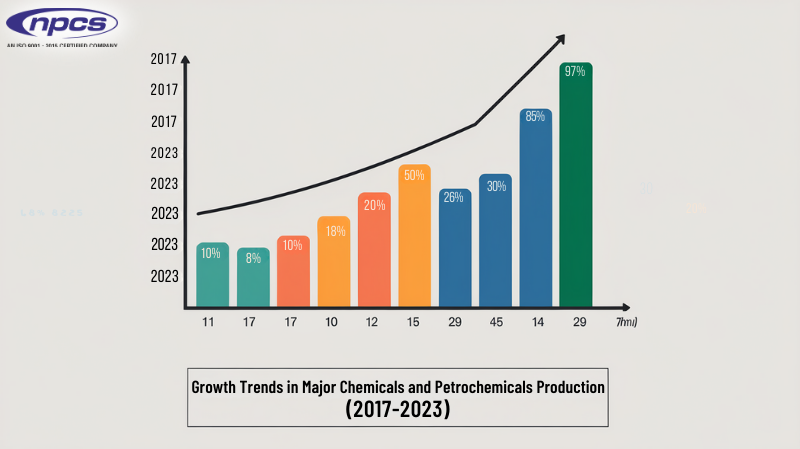PCPIRs are India’s advance industrialization plan in the petrochemical areas. The Indian government has been formulating the concepts and policies of Petroleum, Chemical and Petrochemical Investment Regions (PCPIRs) to provide a policy framework for the organized development of these industries. These regions are expected to create and develop a strong support infrastructure and business climate for the development of petroleum, chemical and petrochemical industries in a planned and environmentally considerate manner.
Since these industries will be earmarked in specific zones, the benefits of PCPIRs will not be limited to only foreign and indigenous investment but also enormous job generation. Such regions are intended to be the center of services related to petroleum, chemical and petrochemical goods processing, manufacturing and trade which will help India’s upward trajectory in the world chemical arena.
Key Features of PCPIRs
PCPIRs is a new concept which believes in the creation of large land parcels in Industries. Whether providing the necessary services for the oil, gas, and chemical processing industries. In the firms themselves from these imposed zones. Some of the impressive characteristics of these zones include:
- Large Regions: Each PCPIR is about an area of about 250 s.q.km with 40% of the area put aside for various processing activities to the petrochemical sector. He ensures there is enough room for the manufacturing and supportive businesses, thereby making it a complete industrial block.
- Anchor Tenants: The most interesting aspect in the PCPIRs is the existence of an anchor space. The space is usually a refinery, or more commonly a company that deals in petrochemical feedstock in bulk. The anchor space is the center point around which the other smaller units and support businesses are set up.
- Integrated Developments: Such areas are designed to enhance industrial clustering of enterprises easing the sharing of resources, infrastructure and services between companies. We anticipate that this model will enhance operational efficiencies and decrease production costs.
- Implementation through the effort of the State Governments: The state governments are crucial in the implementation of PCPIRs such as performing the risk assessments and regulating the regulatory compliance. Also, the central government helps with the provision of the physical external facilities such as the roads, ports. And railways that are crucial for successful completion of the projects.
- Environmental Concerns: The mechanisms of PCPIRs developments always adhere to strict environmental standards so that industrial expansion does not come at the cost of environmental degradation. Every PCPIR has environmental assessments and clearances integrated in the designing and planning stages.
Current Status of PCPIRs
So far, the Indian government has sanctioned four PCPIRs and each of them is in a different level of development. Below is the present status of these regions:
- Gujarat PCPIR (Dahej):
- Approved: February 2009
- Total area: 453 sq km
- Anchor tenant: ONGC Petro Additions Ltd (OPaL)
- Investment made: Rs. 124,363 crore
- Employment generated: 238,000 jobs
Gujarat Dahej PCPIR is one of the most developed regions so far. The coming in of OPAL as the anchor tenant has provoked investment and job opportunities which has placed Gujarat in the forefront of the petrochemical industry in India.
- Andhra Pradesh PCPIR (Visakhapatnam):
- Approved: February 2009
- Total area: 640 sq km
- Anchor tenant: Yet to be finalized
- Investment made: Rs. 15,081 crore
- Employment generated: 139,627 jobs
In as much as the Andhra Pradesh PCPIR has taken some steps forward, the absence of an anchor tenant has affected the rate of growth. Nevertheless the region has seen a huge influx of investment and employment generation proving its promise.
- Odisha PCPIR (Paradip):
- Approved: December 2010
- Total area: 284.15 sq km
- Anchor tenant: Indian Oil Corporation Limited (IOCL)
- Investment made: Rs. 47,000 crore
- Employment generated: 40,000 jobs
The Paradip petrochemical complex in Odisha has already seen great industrial activity supporting the plans that IOCL anchors. This region is further expected to grow as many more industries come up in the region.
- Tamil Nadu PCPIR:
- The state government vitiated the geography of the PCPIR planned for establishment in Tamil Nadu in February 2020.
- The government shelved the Tamil Nadu PCPIR despite these plans, which was unfortunate. The state government gave up on the initiative for reasons such as adverse environmental impact and public dissent.
Economic Impact and Job Creation
The PCPIRs are projected to contribute significantly to the economy. These areas aim to attract huge investments and create jobs in many sectors. Some key parameters are listed below:
- Total expected investment: Rs. 7.63 lakh crore
- Current investments/commitments: Rs. 2.27 lakh crore
- Projected total employment: 33.83 lakh persons
- Current employment: 4.21 lakh persons (direct and indirect)
The tremendous investment and employment generating potential reaffirms the relevance of the PCPIRS in the industrialization process and India’s aspirations of being the world’s factory.
Challenges Facing PCPIRs
Notwithstanding the optimistic perspective, there are quite a number of challenges. It should be tackled for PCPIRs to be put into place correctly:
- Delay in the Confirmation of Anchor Tenants: Some areas like Andhra Pradesh PCPIR still don’t have a registered anchor tenant, thus halting the progress of other phases.
- Environmental Clearance Procedures: Inevitably, too much time has been spent on the following steps: social impact assessments and environmental compliance-related consultations. All these stands are good, for they assist in supporting the ethics of managing environmental resources. But they have worked to extend the periods for which projects were expected to take.
- Infrastructure Development: The factor of connectivity and infrastructure development in itself remains one of the major concerns in some of the regions designated as PCPIRs especially those in the interiors. There is hence no doubt that we had to improve the road, rail, port, and shipping connections for effective transportation of goods and raw materials.
- Public Perception and Opposition: In some instances, people residing in the neighborhood have been against the setting up of such zones for fear of environmental harm as well as displacement. The example of the Tamil Nadu PCPIR stands most clearly shows how people’s opposition can put off such projects.
Conclusion
The government has designed the distribution of PCPRs as a comprehensive policy to enhance the petrochemical industry. These regions’ facilities are expected to attract large industrial investments. Their interdependencies will actively operate thereby creating jobs and creating the necessary infrastructure.
However, even with the creation of geographical regions, segregation of the population controlling such regions. Their functions cannot be on such easy, there are many challenges regarding anchor tenants or green lighting. Building infrastructures that need to be tackled in order for PCPIRs to be fully effective and succeed.
Helping to rationalize the geographical distribution and reduce the intra-policies of the member states. These areas have the potential to make India the hub for the world’s petrochemicals. If you put the right structures in place and maintain efficiency and discipline even in the distribution of labor. Clean and sustainable industrial development being the focus worldwide, getting implementation right in the case of PCPIRs. Moreover, it will not only add to the economy of India, but furthermore, it will also serve as an example to plenty of nations. How industrial growth can happen without harming Mother Earth.
Note: If you have any questions related to opening any manufacturing business , contact us Niir.org
Read related blogs: Npcs blog






